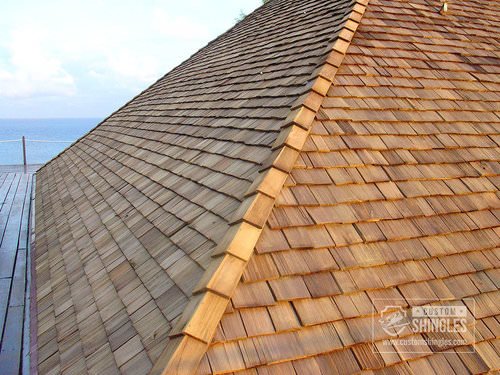What Is the Difference Between Wood Shingles and Wood Shakes?
To most passersby, the difference between a shake and shingle roof is difficult to distinguish. But to the trained eye, the differences are noticeable and dramatic.
How Wood Shingles Differ From Wood Shakes
Wood Shingles always have a smooth and uniform look, not just across each plate but over an entire roof. This is due to the traditional manufacturing method of sawing off singular cedar shingles from one block of wood. Wood shakes, on the other hand, are traditionally hand split, which leads to a rougher texture and finish. An appearance like this manifests as a lack of uniformity across each shake and covering for the entirety of the roof.
More On Wood Roof Shingles
Today, shingles are no longer sawn but rather manufactured by machines — meaning their uniform nature is only enhanced. When you hold a single tile in your hands, you’ll notice that both sides are smooth and consistent, and the overall piece tapers for ease in installation.
More On wood Roof Shakes
Modern wood shakes are also made using contemporary technology. One side will deliver the hand split texture that some homeowners love, but the opposite side is typically smooth and sawn. Shakes are also much thicker than shingles, which leads to a much different appearance after installation.
Different Types of Grains in Cedar Shakes and Shingles
Another important factor to consider when choosing between a roof covered in shakes or shingles is the grain. You have three options to choose from, depending on the appearance and performance of each style:
Edge Grain: When the wood of a shingle or shake is cut perpendicular to the tree's rings, it’s called an edge grain. This is the highest quality cut you can get due to its stability — meaning that with an edge cut, your roofing tiles are unlikely to distort over time. You'll also generally pay more for a product that's cut with an edge grain, due to its long-term durability and strength.
Flat Grain: Flat grain shakes and shingles are opposite of edge grain because they're cut parallel to the tree's rings. An issue with a flat grain wood shake is that it becomes less stable and therefore is much more likely to split over time.
Slash Grain: Slash grain is when the roofing piece is cut at an angle to the tree's rings. This is the least desirable cut due to its overall appearance and durability.
Various Types of Shake Roof Styles
Wood shakes can be split or sawn in multiple ways, each of which leads to a unique look and feel. You can choose heavy split and resawn shakes — this design is where the back is sawn, but the front is split in a method to show the natural wood. A heavy split is perhaps the most rugged look you can find in shakes. Medium split and resawn shakes are not as thick and heavy, though they also have the rough and rustic texture. Tapersawn shakes are closer to shingles in appearance, providing the least rustic aesthetic among the three styles.
The Benefits of Adding Shingles
A perk to adding shingles into your roofing or siding is their protective nature. Being smoothly sawn on both sides allows for a sleek design and increased protection against fires.
Stacking shingles on top of one another can also help in colder climates where retaining heat and eliminating cold leaks from the outside are crucial. Cottages and cabins will often find the design and performance of shingles to be a significant advantage in keeping the interior warm. The overlapping and somewhat bulky appearance of stacked wood shingles will provide a safe haven and hint at the atmosphere to be found inside.
Shingles are also great for complementing the scenic and natural beauty around your home while giving new depth and dimension to your exterior facade. Different styles of wood shingles include fishscale, diamond, sawtooth and steam-bent, each adding a precise shape to your home and also highlighting the conventional and unconventional aspects that make your house unique.
Benefits of Wooden Shakes
If you're interested in giving your home character and capturing attention, wood shakes may be your match. They require an extensive manufacturing and installation process, ensuring your house will be well covered and protected from all elements. A rustic appearance is quite common with shake-styled roofs, helping to enhance the traditional aspects of your home's exterior or emphasize a Victorian-era mansion. Felt is installed in between each shake, and each tile can often be up to one inch in thickness, providing your roof or siding extra secure padding.
Which Is Best for My Home?
How do you choose between wood shakes and wood shingles for your home, in either roofing or siding styling? You should always start by looking at your home’s existing architecture. By analyzing the way your home is already built, you can determine which fit you think is better for its style and look. Wood shakes are ideal for matching natural scenery around the home, resting easily atop both traditional and ranch-style homes. Shingles work best when complementing cabins or cottages — however, these too can be adapted to enhance a residential home.
Another area to consider is how durable your shingle materials will be and how much life and stability you can get from each. Families looking to make their house survive for years and years might consider a teak shake, as it's considered a lifelong product of up to 80 years.
Wallaba is the second most durable option, giving your home strength and security for up to 60 years, though 50 is the average lifespan. However, seeing as the housing market is always changing and styles come in and out, a cedar shake might be the best option for you. It has a baseline lifespan of 30 years, but with the proper care, these shingles can stay intact for up to 50 years.
The Cost of a Shake Roof vs. a Shingle Roof
Cost is always an important factor when making decisions for your home. So, what is the cost difference between shakes and shingles? You should begin by expecting to pay more for wooden shakes than for shingles. The reason for this lies heavily in the fact that the manufacturing and installation of shakes are much more extensive than with shingles. So how much more you can expect to pay for shakes over shingles? A good rule of thumb is that you’ll often pay up to a 50 percent premium, though in some cases, shakes can cost twice as much as a shingle installation.
It's also good to discuss the types of materials used in your roofing or siding installation. Cedar is a popular choice and rightfully so, as it's the most cost-effective option for covering your roof. Wallaba is a second requested material, but be prepared for an estimated cost that runs around 30 percent more than a cedar shake. As for teak, its durability and longevity come with a price — a teak shingle or shake could be up to five times more costly than its trusted cedar counterpart.
Get More Information on Our Wood Shakes and Shingles
You can’t choose any random roofing provider when you’re investing in adding wood tile options to your roof or siding. You need a source of experience and knowledge — a provider that works with natural wood roofing every day. That’s exactly who we are at Custom Shingles. We specialize in custom wood roofing and siding solutions in both the manufacturing and installation processes.
When you want the best for your home, we deliver the best of both rooftop wood shakes and cedar siding options. We’re here to answer your questions, offer information and provide a quote on the installation of our products for your home.
Call today at (877) 323-3553 or contact us for pricing on shakes and shingles.
Request a Quote
Got a question? Send us an email, using the form below, or call our office at 386-487-1015 (local) or (877) 323-3553 (toll-free)








